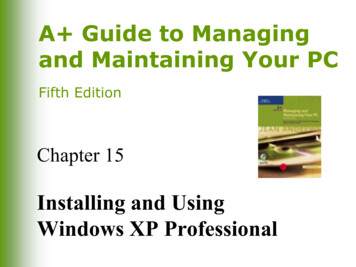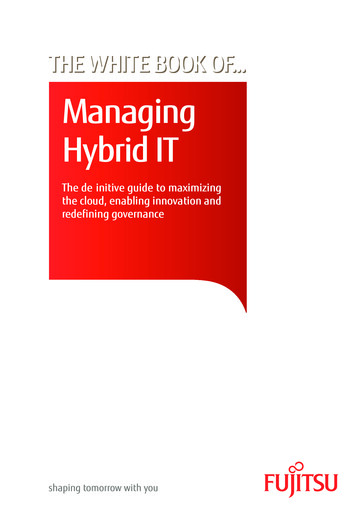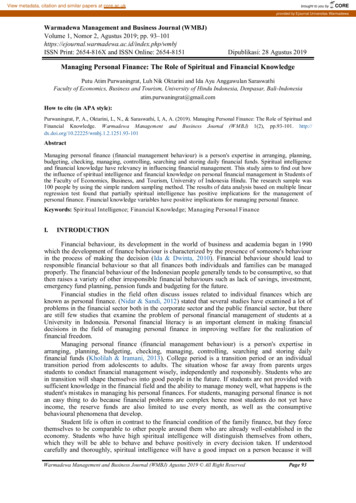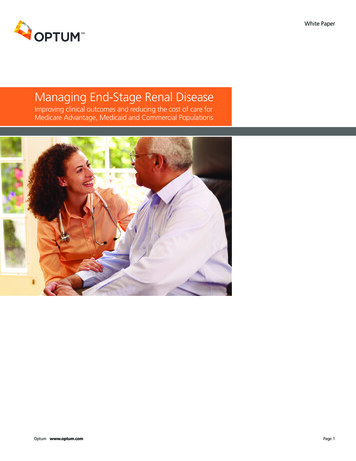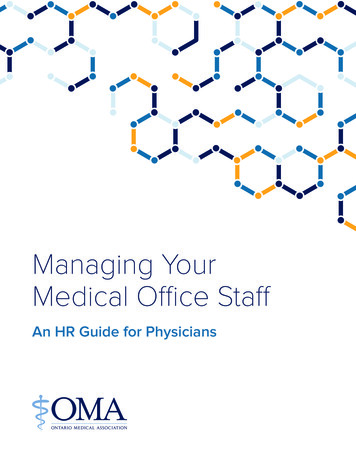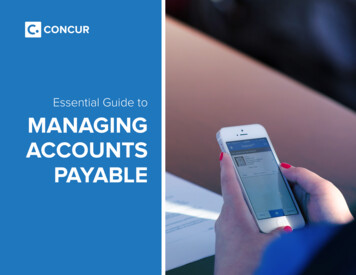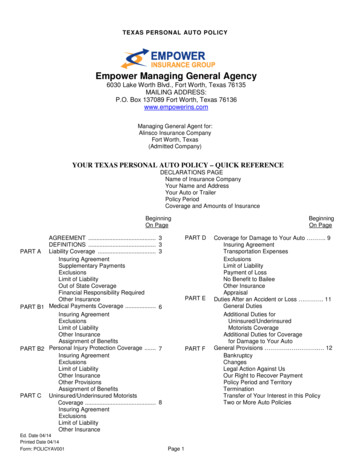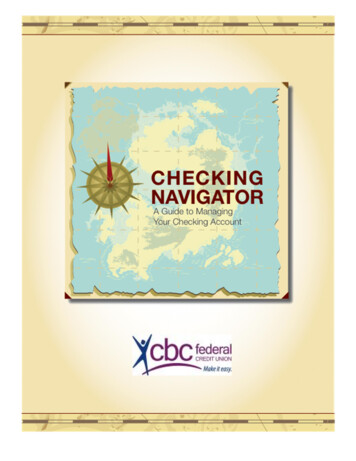
Transcription
A G ui d e t o M a n a g i n g Y our C h e ck i n g A c c oun tTABLE OF CONTENTSIntroduction3General Guidelines for Successful Account Management3Managing Your Checking Account1. Check Register42. Planning63. Recording Your Transactions74. Balancing Your Account9Before Making a Purchase11Check Writing Checklist12Things to Know About Overdrafts13How We Can Help15Acknowledgement Form17Glossary of Terms18 2
A G ui d e t o M a n a g i n g Y our C h e ck i n g A c c oun tIntroductionAt CBC FCU, we want you to get the most out of your relationship with us. This Guide is justone of the ways that we try to simplify managing your checking account and help you eliminatethe expense and inconvenience of overdrafts.This Guide covers how to better manage your checking account to avoid overdraft fees. Weoffer a number of services and products that can help you manage your money, including:„„„„„„Online Bill PayAutomatic Payments and TransfersDebit CardATMsChecksDirect DepositsThroughout this Guide you’ll see definitions of some of the financial terms we use and that you seeon your checking account statement. Understanding these terms can help you avoid overdrafts.If you have questions about the information in this Guide or about your account, we will be happy tohelp you.When you have read this Quick Reference and feel that you understand the information, sign theacknowledgement form on page 17 and bring it in to any branch. At that time, one of ourrepresentatives will help you determine which services and accounts are right for you.General Guidelines for Successful Account Management„„„„„Keep good records. Record all your transactions, including those that can be easilyforgotten.Monitor your checking account activity regularly.Balance your checking account each month.Plan for the “unexpected.” Save.Don’t spend more than you have.“Don’t spend more than you have” sounds like good advice — and it is. But it doesn’t address thecomplexity of managing your life, your finances and your checking account. This Guide will help byproviding information you need to manage your checking account successfully. 3
A G ui d e t o M a n a g i n g Y our C h e ck i n g A c c oun tManaging Your Checking Account1.Check RegisterWhen you opened your checking account with us we provided you a check register. Acheck register is a great way to record all of your transactions, not just checks.NumberCheckDateDescription of TransactionPayment/ DebitDepositBalanceIf you don’t have a check register, you can get one from us, create one of your own insoftware like Microsoft Excel, find one online or just use a notebook. The point is tohave a tool you use regularly to keep track of the money coming in and going out ofyour account.Make sure to use your check register and write down:Every transaction made including debit card and ATM transactions.Every fee assessed ― ATM fees, monthly service fees, ATM fees charged byother institutions, etc.„ ACH auto-debit transactions ― the bills or payments you set up to payautomatically from your account that can be overlooked easily.„ Auto-transfers ― money set up to transfer from your checking account to a carloan, savings account or other account that can be over-looked easily.„„Each month we provide you with your checking account statement. Your statement is arecord of all the transactions that have been posted to your account since your laststatement. 4
A G ui d e t o M a n a g i n g Y our C h e ck i n g A c c oun tThe balance you have in your check register may be different than the balance yousee on your statement, at the ATM, or the balance you see for your account in ouronline banking system. This is because the balance we show for your account maynot include transactions you have made that have not cleared. However, your checkregister should include all your transactions. By recording all of your transactions,you’ll have a good idea of what you really have in your account.You can avoid the penalties of overdrawing your account by keeping a carefulrecord of what goes in and comes out of it. After all, it’s your money.TERMS TO KNOWDirect DepositHaving money, such as paychecks or SocialSecurity checks, automatically andelectronically put into your account.ACH Auto-debitAny transaction that you authorize to be paidautomatically using your checking accountnumber and our routing number, such as autility bill or car insurance bill.Online Bill PaymentA method of conveniently paying your billsusing our website.Recurring Debit CardTransactionAny regularly scheduled payment (such as autility bill, mortgage payment, or car loan)that you authorize using your debit cardnumber. 5
A G ui d e t o M a n a g i n g Y our C h e ck i n g A c c oun t2.Planning„„Record all of your recurring transactions (those that you have set up to happenautomatically on a regular schedule) for the month.Create a reference list like the one below to help you remember to record eachtransaction every month. You can use simple spreadsheet software, or even justa lined notebook.Recurring transactions (monthly)TransactionDateAmountPayroll deposit (direct deposit)Other deposits(set up as many lines as youneed to itemize them here)Mortgage/rentCar paymentCar insuranceHome insuranceOther recurring payments(set up as many lines as youneed to itemize them here)Monthly service chargeOther financial institution feesNote: Remember to record all transactions that you have set up directly withmerchants (ACH auto-debit or online bill payment), as well as recurring debitcard transactions. 6
A G ui d e t o M a n a g i n g Y our C h e ck i n g A c c oun t3.Recordi ng Your Tra nsactions„„„Record all transactions in your check register.Remember to record your recurring transactions. You may want to do this at thebeginning of every month.Be sure to record easy to overlook transactions like:······CheckNumberEveryday debit card transactions, also called point of sale,or POS transactionsATM withdrawalsACH auto-debitsATM feesTransfer feesOverdraft feesPayment/DebitDateDescription of Transaction3/7Payday10813/8ACME Grocery Store 188.75 500.00Debit card3/8Coffee Shop 5.25 494.75ATM3/8ATM at Grocery Store 30.00 464.75Debit card3/8Nail Salon 24.75 440.00Auto-bill3/10Car insurance 129.86 310.143/14Service Charge 10.00 300.14 7 DepositBalance 688.75 688.75
A G ui d e t o M a n a g i n g Y our C h e ck i n g A c c oun tTERMS TO KNOWEveryday debit cardtransaction or point ofsale (POS) transactionA one-time debit transaction (such as using yourcard at a grocery store or restaurant). You cantypically choose to use your debit card one of twoways for everyday POS purchases. You can chooseto make your purchase a debit transaction or acredit transaction. Debit is a PIN-based transaction,which means you enter your PIN number on akeypad at the time of purchase. When you choosedebit, the money you spend comes out of youraccount faster. Credit is a signature-basedtransaction, which means you sign your name atthe time of purchase. When you choose credit, themoney you spend may take a little longer to comeout of your account. Although it’s labeled a credittransaction, using your debit card in this way is notthe same as using a credit card.ATM feeA fee charged by a bank or credit union for usingthe ATM to check your balance, withdraw cash oruse other services. Most banks and credit unionswill charge you a fee if you are not their customeror member. Some banks and credit unions willcharge you a fee for using another bank or creditunion’s ATM.TransferMoving money from one account to anotheraccount.Overdraft Transfer feeWhen you have another account linked to yourchecking account, this is the fee you may pay tohave money transferred automatically to keep fromoverdrawing your account.Overdraft or Insufficient/Non-sufficient Funds (NSF)When there is not enough money in your account tocover your purchases, withdrawals, debit card use,checks, or other expendituresOverdraft feeA fee that a bank or credit union can charge toyour account when the institution covers yourtransaction even though you do not have sufficientfunds available in your account to cover the amountof the transaction when it posts. 8
A G ui d e t o M a n a g i n g Y our C h e ck i n g A c c oun t4.Balancing Your Account„„„„Keep a running total of the money in your account in your check register as yourecord your transactions.Use online banking or your monthly statement to check off transactions thathave cleared or posted to your account.Compare your balance on your register with the balance you get from us. Wemay not show the same balance as your register since your account may stillhave pending transactions that have not posted.To balance your account, you will need to consider the debits and credits thathave not yet posted (pending transactions), as well as transactions you havemade that have not reached the financial institution at all. You may also need toconsider any holds on your account, including check holds and preauthorization holds.Some financial institutions may provide two balances. The current balance(sometimes called ledger balance) does not include any pendingtransactions. The available balance may include pending transactions.We provide your current balance. 9
A G ui d e t o M a n a g i n g Y our C h e ck i n g A c c oun tTERMS TO KNOWPostThe process of clearing transactions on your account.DebitAny transaction that decreases your account balance,such as an ATM withdrawal, debit card transaction,check, transfer to another account, or service fee.CreditAny transaction that increases your balance, such asa deposit, direct deposit, refund, transfer fromanother account, etc.Pending transactionA transaction that you have made but that hasn’tbeen posted to your account yet. These pendingtransactions may give the appearance that youraccount has more money in it than it actually does.Check HoldA delay in crediting the money from a check youdeposit to your account. A check hold allows thefinancial institution to make sure the check properlyclears the account of the person or company whowrote the check. Examples include checks for largeamounts or out-of-state checks.Pre-Authorization HoldA specific dollar amount that some merchants (usuallyhotels, rental car agencies, gas stations andrestaurants) charge to your debit card to verify thatyou have enough money to cover the transaction.This hold amount may be higher or lower than theactual purchase amount and will clear when theactual transaction posts.Current (or ledger) balanceThe balance which reflects all transactions that havecleared (or posted to) your checking account. Yourcurrent balance does not include any pendingtransactions that will affect your balance soon.Available balanceThe balance which is the maximum amount of moneyyou can withdraw or spend from your account today.Your available balance may or may not include anypending transactions you have made. Be sure youhave included your pending transactions when youconsider making withdrawals or purchases. 10
A G ui d e t o M a n a g i n g Y our C h e ck i n g A c c oun tBefore Making a PurchaseKeep these guidelines in mind when you are planning to make a purchase or writea check.When does a transaction post?TRANSACTIONWHENATM WithdrawalTypically posts within a business day.Point of Sale TransactionDebit (PIN) transactions typically post more quicklythan transactions you authorize with your signature.Depending on the merchant, debit transactions maypost immediately or within a business day.Teller withdrawal at your institutionTypically posts the evening it is processed.ACH DebitTypically posts the day you schedule it to pay.Electronic Bill PaymentThe money is taken out of your account first, then itmay take one or two days to get to the person orcompany you are paying if the payment is done asan ACH or up to five days if a paper check is cut.Check written to a merchant orindividualTypically posts in one to three days from the timethe merchant or individual cashes your check.Deposit (cash)Typically posts the evening the transaction wasprocessed.Remember to record fees.Be sure to review your account opening documents or go to our website to verify allfees:Monthly service charge and/or minimum balance to waive service chargeATM fees„ Inquiry fees (over the phone or in person)„ Overdraft fees„„ 11
A G ui d e t o M a n a g i n g Y our C h e ck i n g A c c oun tCheck Writing ChecklistüDo you have enough money in your account to cover the check?(Think current vs. available balance.)üDid you write the check in ink?(Remember, it’s a legal document.)üDid you write the correct date on the check?Checks may not be accepted if they are written with a future date.üDid you totally fill in the “pay to the order of” line?üDid you make sure the numeric and written amounts of thecheck match?üDid you sign the check just like you did on yoursignature card at the financial institution?üDid you record the check in your check register?üDid you record any associated fees?üDid you tell others on the account you have written the check sothey don’t overdraw the account? 12
A G ui d e t o M a n a g i n g Y our C h e ck i n g A c c oun tThings to Know about OverdraftsAn overdraft occurs when there is not enough money in your account to cover atransaction when it posts to your account. Overdrawing your account and havingchecks or electronic payments returned can be embarrassing and cause a lot ofinconvenience. Returned items can lead to additional fees, such as merchant fees(returned check fees) and late fees, or even the loss of check writing privileges.Remember „„Overdrafts can be caused by any type of transaction (check, debit card purchase, ACH,ATM).If a check or electronic payment is returned, you are responsible for the amount of thetransaction, plus any fees associated with the returned item.How to avoid overdrafts„„Use the tips provided in this Guide.Consider Overdraft Protection Services.Overdraft Protection Services(Check with us for details)„„Link to another account (or sweep) ― moves money from another account linked to yourchecking account to cover overdrafts. There may be a fee associated with the transfer.Overdraft Privilege ― an optional service that pays overdrafts and assesses a fee up to apre-set limit. 13
A G ui d e t o M a n a g i n g Y our C h e ck i n g A c c oun tOpt-In/Opt-Out„„„„While your account may provide Overdraft Privilege automatically for checks, ACH andrecurring debit card transactions, you must request this service by opting-in to haveOverdraft Privilege access at the ATM and for everyday debit card transactions.Contact us to find out how you can opt-in.We will provide you with a written confirmation of your consent to opt-in.You can change your opt-in request or completely opt-out of Overdraft Privilege at anytime by contacting us. 14
A G ui d e t o M a n a g i n g Y our C h e ck i n g A c c oun tHow We Can HelpPutting Money in Your Account„„„„„„Direct depositConvenient lobby hoursDrive-thru windowsDeposits at ATMsPhone and Online transfersMobile DepositsTaking Money Out of Your Account„„„„„CBC FCU has ATMs at 6 convenient locations in Ventura County. You may also use yourCBC ATM card in any of the 30,000 CO-OP Network ATMs nationwide with absolutelyno transaction fees or surcharges. Just look for the CO-OP Network logo.Logon to our website www.cbcfcu.org and click on “Branches and ATMs” to find theATM that is the most convenient for you.Additionally, did you know we offer a checking account with Identity Theft RestorationVisit our website, www.cbcfcu.org to find out more about our Security Plus Checkingaccount.CBC FCU offers our members a Visa Debit Card. With Visa , you can pay for yourpurchases and get cash 24-hours a day, 7-days a week, anywhere Visa is accepted.CBC FCU offers free Online\Mobile Banking and Bill Pay. First time Online and MobileBanking users can call 805-988-2151 to get a secure PIN code and get started. You willhave access to your account 24/7. No more mailing checks and spending money onstamps. You can also use the CBC FCU mobile banking app to deposit checks using thecamera on your mobile device! No need to drive to an ATM or branch. 15
A G ui d e t o M a n a g i n g Y our C h e ck i n g A c c oun tTools for Managing Your Account„„„„„„„„„CBC FCU offers free Online\Mobile Banking.Use online banking to monitor pending transactions, posted transactions, balances andinsufficient items.E-mail alerts for daily balances, low balances, insufficient funds, or transactions over acertain amount.Telephone Banking (MyTalk) for pending transactions, posted transactions, balances andinsufficient items.Link another account (such as a savings account) to your checking account in case of anaccidental overdraft.Overdraft Privilege: This service is a feature of your checking account. As long as you’rein good standing, we will pay overdrafts, caused by checks or ACH and recurring debittransactions.Opt-In/Opt-out: To extend your overdraft privilege coverage to include ATM andeveryday debit card transactions you must “opt-in” or request that we add it to youraccount. You can change your opt-in request or completely opt-out of Overdraft Privilegeat any time by contacting us.ATM (balances).Our Deposit Cut-off Time is the close of the business day.Keeping Track of Your Account„„„„Use online banking to keep track of account balances and transfer money from oneaccount to another.Use our online education tool, Checking Navigator, for more help in managing yourchecking account.Use e-mail notifications, if available, to receive daily account balances or alerts if yourbalance is too low or insufficient.Take advantage of our e-statements ― the safe, secure way to get your monthlystatement. 16
A G ui d e t o M a n a g i n g Y our C h e ck i n g A c c oun tAcknowledgement FormCBC FCU and its representatives are always happy to help you choose the products and servicesthat are best suited for your financial management needs. Now that you have a betterunderstanding of how to manage your checking account, avoiding costly errors and overdraftsshould be much easier. And you will also find that you will be able to budget and save moreefficiently as well. Please sign the acknowledgment stating that you have reviewed and understandall the information in this guide and have received acceptable answers to any questions you mayhave.I acknowledge that I have read all the information in this guide. I understand the information andhave received acceptable answers to all my questions.Account Holder SignatureDate 17
A G ui d e t o M a n a g i n g Y our C h e ck i n g A c c oun tGlossary of TermsACHACH Auto-debitAvailable BalanceATM FeeBounced/Returned CheckThe system that connects banks and credit unions to oneanother and enables electronic transactions, such asautomatic payroll deposits, debit card purchases, andonline bill payments to be handled and processedacross financial institutions.Any transaction that you authorize to be paidautomatically using your checking account number andyour bank’s or credit union’s routing number, such as autility or car insurance bill.The maximum amount of money you can withdraw orspend from your account today. This balance may ormay not include any pending transactions you havemade. If your bank or credit union does not includepending transactions when calculating your availablebalance, be sure you have made those calculationsyourself when you consider making withdrawals orpurchases.A fee charged by a bank or credit union for using theirATM to check your balance, withdraw cash or use otherservices. Most banks and credit unions will charge you afee if you are not their customer or member. Somebanks and credit unions will charge you a fee for usinganother bank’s or credit union’s ATM.A check that has been returned to the person or businessyou wrote it to because there is not enough money inyour account to cover the amount of the check. This alsoapplies to payments made through online bill pay. 18
A G ui d e t o M a n a g i n g Y our C h e ck i n g A c c oun tCheck HoldCreditCurrent (or Ledger) BalanceDebitDebit CardDepositA delay in crediting the money from a check you depositto your account. This allows the financial institution tomake sure the check properly clears the account of theperson or company who wrote the check. Examplesinclude checks for large amounts, from out-of-state banksor credit unions. There may also be check holds on youraccount when your account is new.Any transaction that increases your balance, such as adeposit, direct deposit, refunds, transfers from otheraccounts, etc.The balance which reflects all transactions that havecleared (or posted to) your checking account, but doesnot include any pending transactions that will affect yourbalance soon.Any transaction that decreases your account balance,such as an ATM withdrawal, debit card transaction,check, transfer to another account, or service fee.A card, typically carrying a brand or logo such as Visaor MasterCard on the front, that is issued to you by yourbank or credit union. Your debit card can be used tomake purchases at merchants and also to withdraw cash,check your balance and make transfers at ATMs. Theamount of a debit card transaction is deducted directlyfrom your checking account (not to be confused with acredit card).Money you or someone else (like your employer) puts inyour account. 19
A G ui d e t o M a n a g i n g Y our C h e ck i n g A c c oun tAny transaction that you authorize using your debitcard number. Examples include:Debit Card TransactionDirect DepositInsufficient/Non-Sufficient FundsOnline Bill PaymentOverdraft FeePending (or pre-authorized)Transaction·Recurring: a regularly scheduled payment(such as a utility bill).·Everyday: a one-time debit transaction(such as using your card at a grocery storeor restaurant).Having money, such as paychecks and SocialSecurity checks, automatically and electronically putinto your account. With direct deposit, you don’tphysically deposit a check into your account, whichsaves time and ensures the deposit is made on time.When there is not enough money in your account tocover your purchases, withdrawals, debit card use,checks, or other debits.A method of conveniently paying your bills usingyour bank’s or credit union’s website and onlinebanking service.A fee that your bank or credit union can charge toyour account any time you do not have sufficientfunds available in your account to cover the amountof the transaction when it posts.A transaction that hasn’t been posted to your accountyet. Pending transactions may give the appearancethat an account has more or less money in it than itactually does. 20
A G ui d e t o M a n a g i n g Y our C h e ck i n g A c c oun tPoint of Sale (POS)Any transaction made at a merchant with your debitcard. There are two types of POS transactions:1. A Debit Transaction is a PIN-based transaction,which means you enter your PIN number on akeypad at the time of purchase. When youchoose debit, the money you spend comes out ofyour account faster.2. A Credit Transaction is a signature-basedtransaction, which means you sign your name atthe time of purchase. When you choose credit,the money you spend may take a little longer tocome out of your account.PostingPosting Cut-off TimesPre-Authorization HoldTransferThe process of clearing transactions on your account.The time when the financial institution’s processing dayends. Transactions made after the posting cutoff time willbe processed with the next day’s transactions.A specific dollar amount that a merchant charges to yourdebit card to verify that you have enough money to coverthe transaction.Moving money from one account to another account.Many transfers can be automatic between accounts atyour financial institution. 21
A Guide to Managing Your Checking Account Managing Your Checking Account 1. Check Register When you opened your checking account with us we provided you a check register. A check register is a great way to record all of your transactions, not just checks. If you don't have a check register, you can get one from us, create one of your own in
